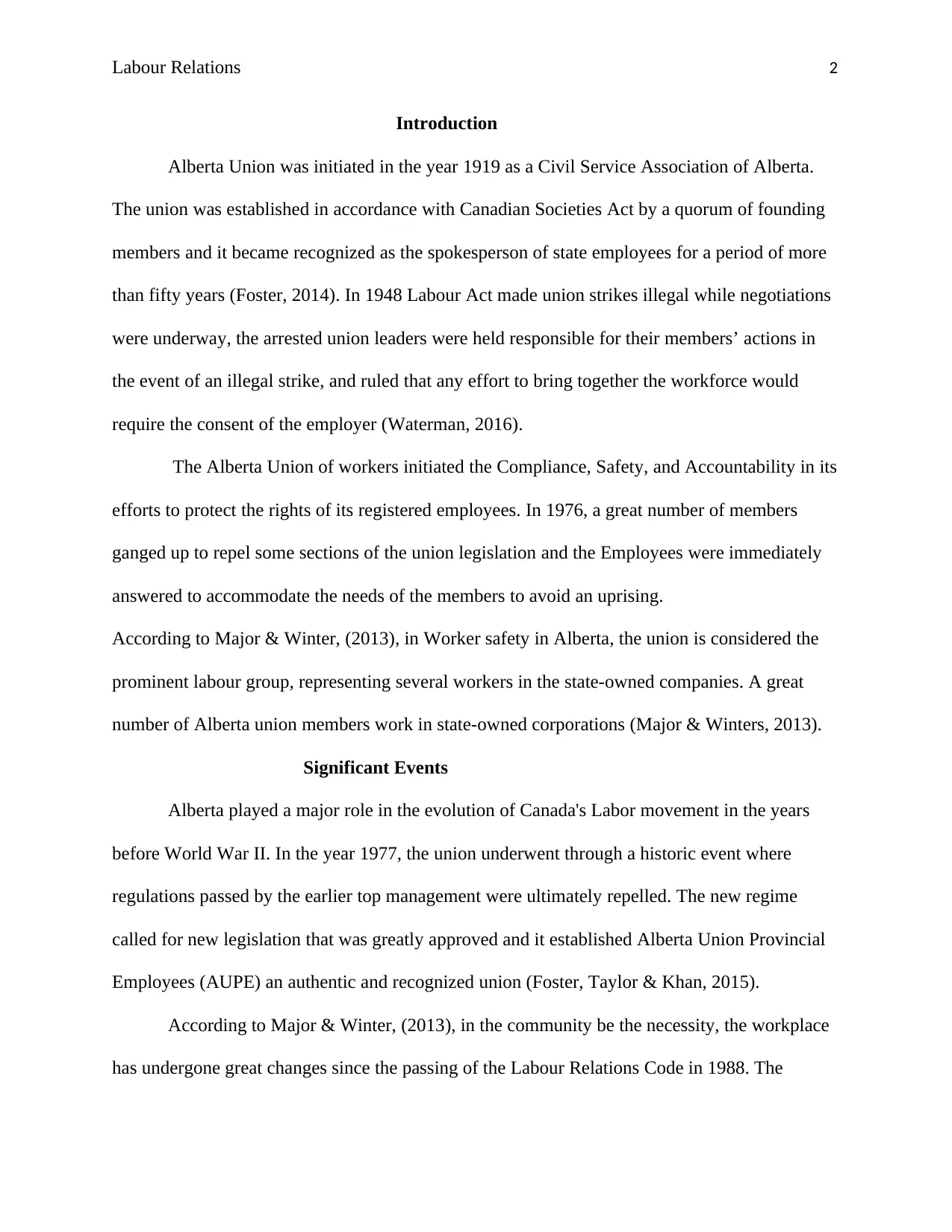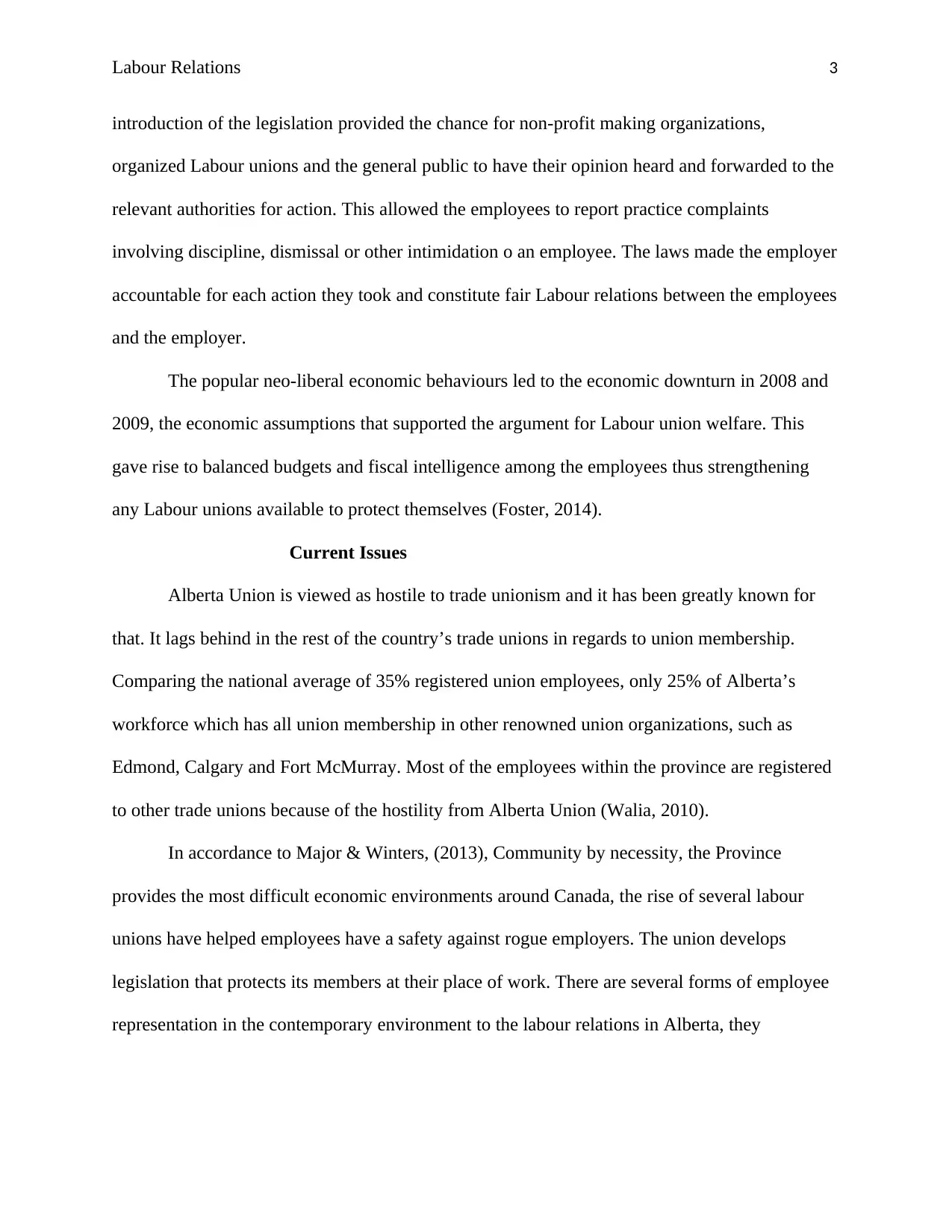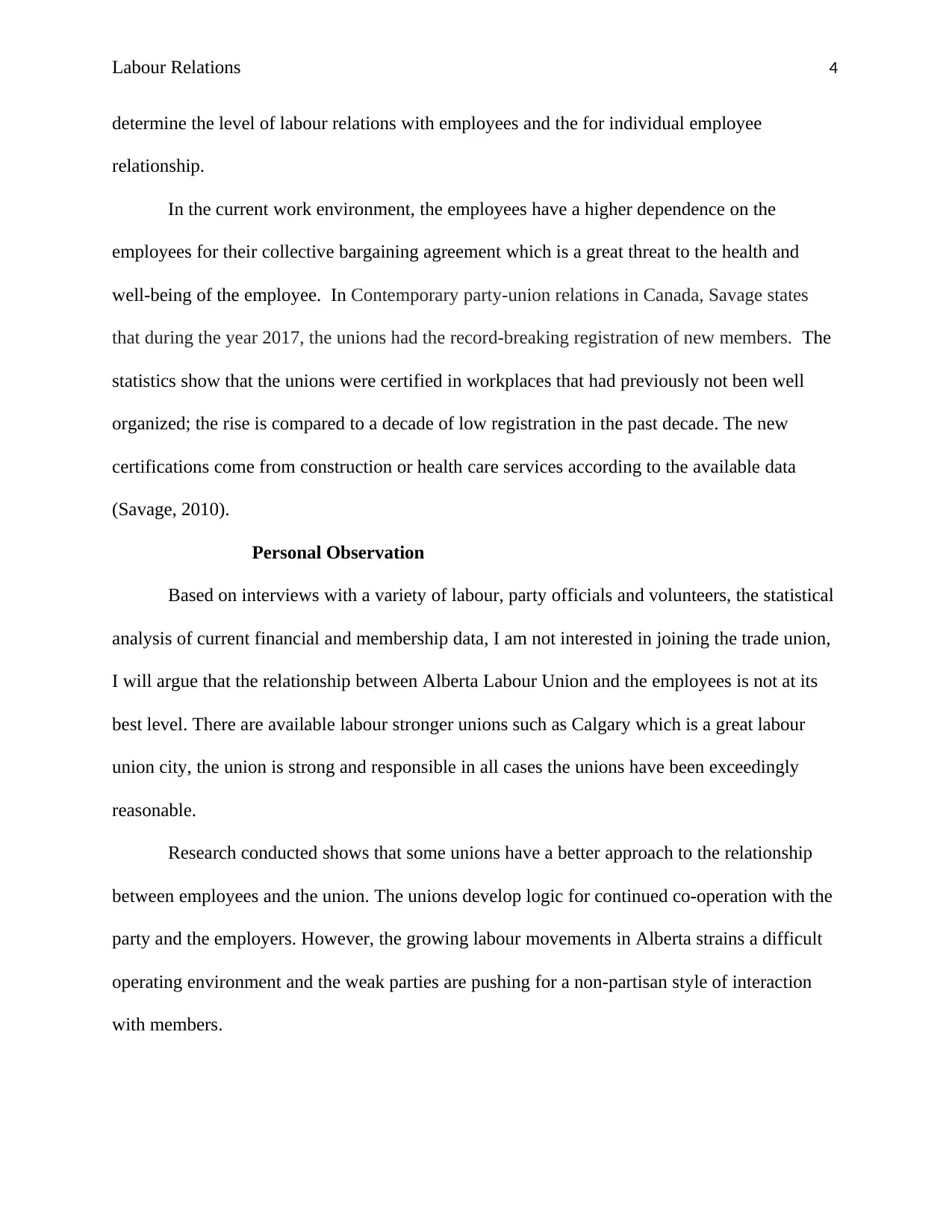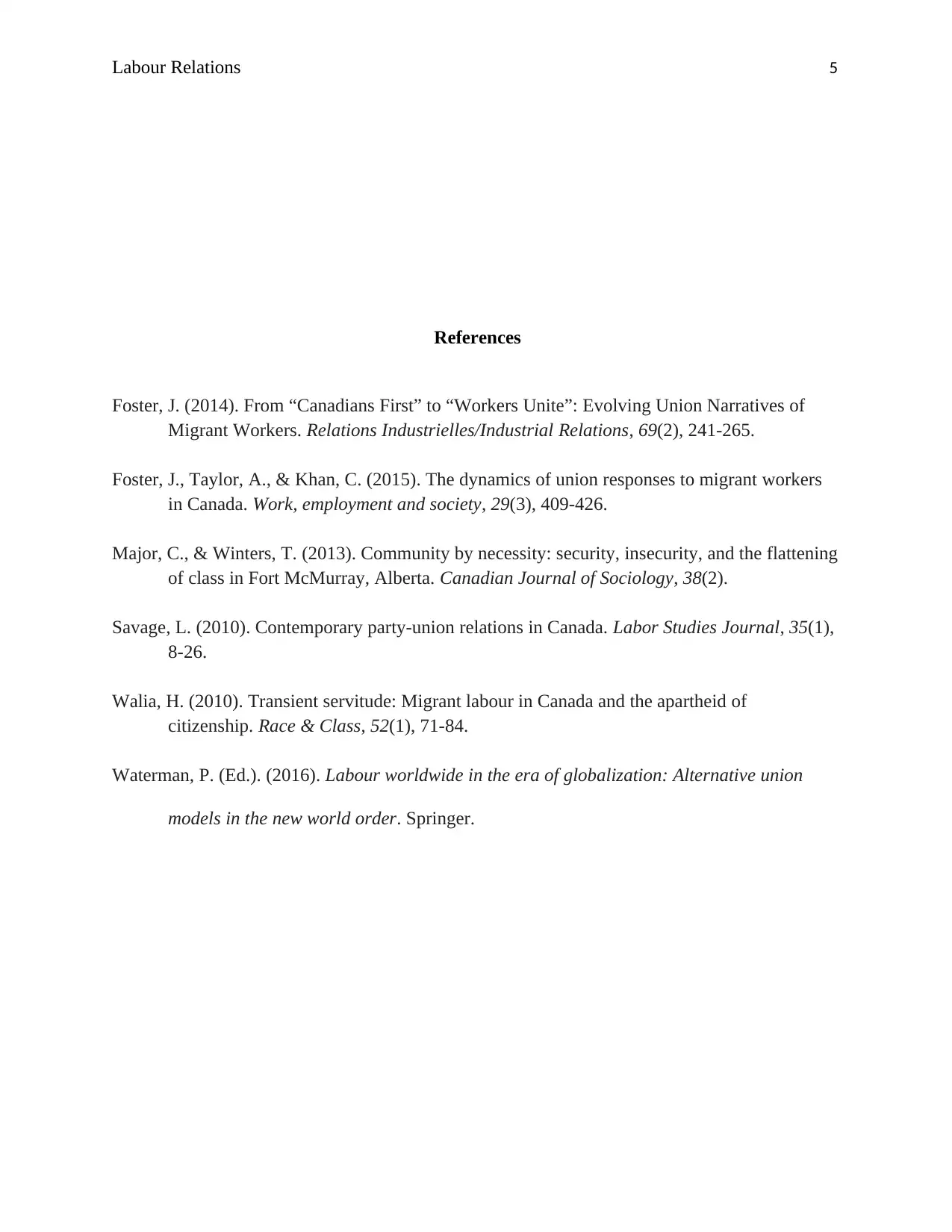Analysis of Alberta Union Labour Relations - Report
VerifiedAdded on 2023/04/26
|5
|1165
|416
Report
AI Summary
This report provides an overview of labour relations in Alberta, with a specific focus on the Alberta Union. It begins with a historical introduction to the union, tracing its origins as the Civil Service Association of Alberta and its evolution within the Canadian labour movement. The report highlights significant events, such as the changes brought about by the Labour Relations Code in 1988 and the impact of neo-liberal economic behaviors. Current issues, including the Alberta Union's perceived hostility towards trade unionism and its relatively low union membership compared to the national average, are also examined. The report references academic sources to support its analysis, offering insights into the challenges faced by the union and the broader labour landscape in Alberta. The author also provides a personal observation based on interviews and statistical analysis, arguing that the relationship between the Alberta Labour Union and employees is not at its best level. The report concludes by referencing several key academic sources used in the research.

Running Head: Labour Relations 1
Albert Union Labour Relations
Name:
Course:
Instructor:
Date:
Albert Union Labour Relations
Name:
Course:
Instructor:
Date:
Paraphrase This Document
Need a fresh take? Get an instant paraphrase of this document with our AI Paraphraser

Labour Relations 2
Introduction
Alberta Union was initiated in the year 1919 as a Civil Service Association of Alberta.
The union was established in accordance with Canadian Societies Act by a quorum of founding
members and it became recognized as the spokesperson of state employees for a period of more
than fifty years (Foster, 2014). In 1948 Labour Act made union strikes illegal while negotiations
were underway, the arrested union leaders were held responsible for their members’ actions in
the event of an illegal strike, and ruled that any effort to bring together the workforce would
require the consent of the employer (Waterman, 2016).
The Alberta Union of workers initiated the Compliance, Safety, and Accountability in its
efforts to protect the rights of its registered employees. In 1976, a great number of members
ganged up to repel some sections of the union legislation and the Employees were immediately
answered to accommodate the needs of the members to avoid an uprising.
According to Major & Winter, (2013), in Worker safety in Alberta, the union is considered the
prominent labour group, representing several workers in the state-owned companies. A great
number of Alberta union members work in state-owned corporations (Major & Winters, 2013).
Significant Events
Alberta played a major role in the evolution of Canada's Labor movement in the years
before World War II. In the year 1977, the union underwent through a historic event where
regulations passed by the earlier top management were ultimately repelled. The new regime
called for new legislation that was greatly approved and it established Alberta Union Provincial
Employees (AUPE) an authentic and recognized union (Foster, Taylor & Khan, 2015).
According to Major & Winter, (2013), in the community be the necessity, the workplace
has undergone great changes since the passing of the Labour Relations Code in 1988. The
Introduction
Alberta Union was initiated in the year 1919 as a Civil Service Association of Alberta.
The union was established in accordance with Canadian Societies Act by a quorum of founding
members and it became recognized as the spokesperson of state employees for a period of more
than fifty years (Foster, 2014). In 1948 Labour Act made union strikes illegal while negotiations
were underway, the arrested union leaders were held responsible for their members’ actions in
the event of an illegal strike, and ruled that any effort to bring together the workforce would
require the consent of the employer (Waterman, 2016).
The Alberta Union of workers initiated the Compliance, Safety, and Accountability in its
efforts to protect the rights of its registered employees. In 1976, a great number of members
ganged up to repel some sections of the union legislation and the Employees were immediately
answered to accommodate the needs of the members to avoid an uprising.
According to Major & Winter, (2013), in Worker safety in Alberta, the union is considered the
prominent labour group, representing several workers in the state-owned companies. A great
number of Alberta union members work in state-owned corporations (Major & Winters, 2013).
Significant Events
Alberta played a major role in the evolution of Canada's Labor movement in the years
before World War II. In the year 1977, the union underwent through a historic event where
regulations passed by the earlier top management were ultimately repelled. The new regime
called for new legislation that was greatly approved and it established Alberta Union Provincial
Employees (AUPE) an authentic and recognized union (Foster, Taylor & Khan, 2015).
According to Major & Winter, (2013), in the community be the necessity, the workplace
has undergone great changes since the passing of the Labour Relations Code in 1988. The

Labour Relations 3
introduction of the legislation provided the chance for non-profit making organizations,
organized Labour unions and the general public to have their opinion heard and forwarded to the
relevant authorities for action. This allowed the employees to report practice complaints
involving discipline, dismissal or other intimidation o an employee. The laws made the employer
accountable for each action they took and constitute fair Labour relations between the employees
and the employer.
The popular neo-liberal economic behaviours led to the economic downturn in 2008 and
2009, the economic assumptions that supported the argument for Labour union welfare. This
gave rise to balanced budgets and fiscal intelligence among the employees thus strengthening
any Labour unions available to protect themselves (Foster, 2014).
Current Issues
Alberta Union is viewed as hostile to trade unionism and it has been greatly known for
that. It lags behind in the rest of the country’s trade unions in regards to union membership.
Comparing the national average of 35% registered union employees, only 25% of Alberta’s
workforce which has all union membership in other renowned union organizations, such as
Edmond, Calgary and Fort McMurray. Most of the employees within the province are registered
to other trade unions because of the hostility from Alberta Union (Walia, 2010).
In accordance to Major & Winters, (2013), Community by necessity, the Province
provides the most difficult economic environments around Canada, the rise of several labour
unions have helped employees have a safety against rogue employers. The union develops
legislation that protects its members at their place of work. There are several forms of employee
representation in the contemporary environment to the labour relations in Alberta, they
introduction of the legislation provided the chance for non-profit making organizations,
organized Labour unions and the general public to have their opinion heard and forwarded to the
relevant authorities for action. This allowed the employees to report practice complaints
involving discipline, dismissal or other intimidation o an employee. The laws made the employer
accountable for each action they took and constitute fair Labour relations between the employees
and the employer.
The popular neo-liberal economic behaviours led to the economic downturn in 2008 and
2009, the economic assumptions that supported the argument for Labour union welfare. This
gave rise to balanced budgets and fiscal intelligence among the employees thus strengthening
any Labour unions available to protect themselves (Foster, 2014).
Current Issues
Alberta Union is viewed as hostile to trade unionism and it has been greatly known for
that. It lags behind in the rest of the country’s trade unions in regards to union membership.
Comparing the national average of 35% registered union employees, only 25% of Alberta’s
workforce which has all union membership in other renowned union organizations, such as
Edmond, Calgary and Fort McMurray. Most of the employees within the province are registered
to other trade unions because of the hostility from Alberta Union (Walia, 2010).
In accordance to Major & Winters, (2013), Community by necessity, the Province
provides the most difficult economic environments around Canada, the rise of several labour
unions have helped employees have a safety against rogue employers. The union develops
legislation that protects its members at their place of work. There are several forms of employee
representation in the contemporary environment to the labour relations in Alberta, they
⊘ This is a preview!⊘
Do you want full access?
Subscribe today to unlock all pages.

Trusted by 1+ million students worldwide

Labour Relations 4
determine the level of labour relations with employees and the for individual employee
relationship.
In the current work environment, the employees have a higher dependence on the
employees for their collective bargaining agreement which is a great threat to the health and
well-being of the employee. In Contemporary party-union relations in Canada, Savage states
that during the year 2017, the unions had the record-breaking registration of new members. The
statistics show that the unions were certified in workplaces that had previously not been well
organized; the rise is compared to a decade of low registration in the past decade. The new
certifications come from construction or health care services according to the available data
(Savage, 2010).
Personal Observation
Based on interviews with a variety of labour, party officials and volunteers, the statistical
analysis of current financial and membership data, I am not interested in joining the trade union,
I will argue that the relationship between Alberta Labour Union and the employees is not at its
best level. There are available labour stronger unions such as Calgary which is a great labour
union city, the union is strong and responsible in all cases the unions have been exceedingly
reasonable.
Research conducted shows that some unions have a better approach to the relationship
between employees and the union. The unions develop logic for continued co-operation with the
party and the employers. However, the growing labour movements in Alberta strains a difficult
operating environment and the weak parties are pushing for a non-partisan style of interaction
with members.
determine the level of labour relations with employees and the for individual employee
relationship.
In the current work environment, the employees have a higher dependence on the
employees for their collective bargaining agreement which is a great threat to the health and
well-being of the employee. In Contemporary party-union relations in Canada, Savage states
that during the year 2017, the unions had the record-breaking registration of new members. The
statistics show that the unions were certified in workplaces that had previously not been well
organized; the rise is compared to a decade of low registration in the past decade. The new
certifications come from construction or health care services according to the available data
(Savage, 2010).
Personal Observation
Based on interviews with a variety of labour, party officials and volunteers, the statistical
analysis of current financial and membership data, I am not interested in joining the trade union,
I will argue that the relationship between Alberta Labour Union and the employees is not at its
best level. There are available labour stronger unions such as Calgary which is a great labour
union city, the union is strong and responsible in all cases the unions have been exceedingly
reasonable.
Research conducted shows that some unions have a better approach to the relationship
between employees and the union. The unions develop logic for continued co-operation with the
party and the employers. However, the growing labour movements in Alberta strains a difficult
operating environment and the weak parties are pushing for a non-partisan style of interaction
with members.
Paraphrase This Document
Need a fresh take? Get an instant paraphrase of this document with our AI Paraphraser

Labour Relations 5
References
Foster, J. (2014). From “Canadians First” to “Workers Unite”: Evolving Union Narratives of
Migrant Workers. Relations Industrielles/Industrial Relations, 69(2), 241-265.
Foster, J., Taylor, A., & Khan, C. (2015). The dynamics of union responses to migrant workers
in Canada. Work, employment and society, 29(3), 409-426.
Major, C., & Winters, T. (2013). Community by necessity: security, insecurity, and the flattening
of class in Fort McMurray, Alberta. Canadian Journal of Sociology, 38(2).
Savage, L. (2010). Contemporary party-union relations in Canada. Labor Studies Journal, 35(1),
8-26.
Walia, H. (2010). Transient servitude: Migrant labour in Canada and the apartheid of
citizenship. Race & Class, 52(1), 71-84.
Waterman, P. (Ed.). (2016). Labour worldwide in the era of globalization: Alternative union
models in the new world order. Springer.
References
Foster, J. (2014). From “Canadians First” to “Workers Unite”: Evolving Union Narratives of
Migrant Workers. Relations Industrielles/Industrial Relations, 69(2), 241-265.
Foster, J., Taylor, A., & Khan, C. (2015). The dynamics of union responses to migrant workers
in Canada. Work, employment and society, 29(3), 409-426.
Major, C., & Winters, T. (2013). Community by necessity: security, insecurity, and the flattening
of class in Fort McMurray, Alberta. Canadian Journal of Sociology, 38(2).
Savage, L. (2010). Contemporary party-union relations in Canada. Labor Studies Journal, 35(1),
8-26.
Walia, H. (2010). Transient servitude: Migrant labour in Canada and the apartheid of
citizenship. Race & Class, 52(1), 71-84.
Waterman, P. (Ed.). (2016). Labour worldwide in the era of globalization: Alternative union
models in the new world order. Springer.
1 out of 5
Related Documents
Your All-in-One AI-Powered Toolkit for Academic Success.
+13062052269
info@desklib.com
Available 24*7 on WhatsApp / Email
![[object Object]](/_next/static/media/star-bottom.7253800d.svg)
Unlock your academic potential
Copyright © 2020–2025 A2Z Services. All Rights Reserved. Developed and managed by ZUCOL.





